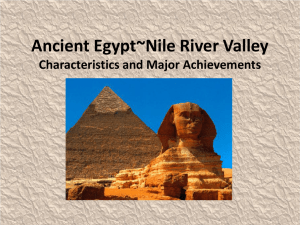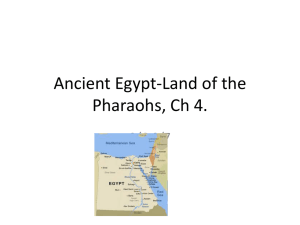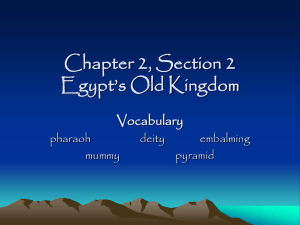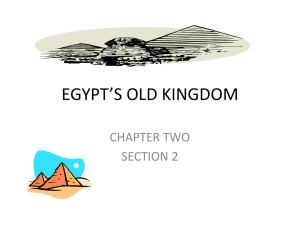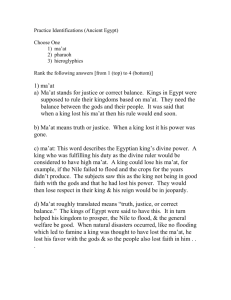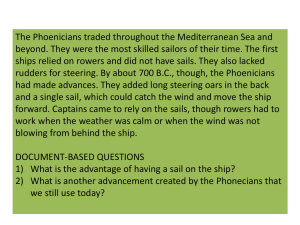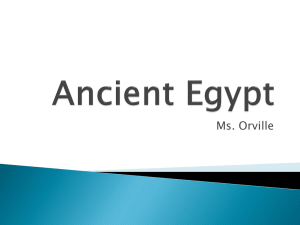Pharaoh
advertisement
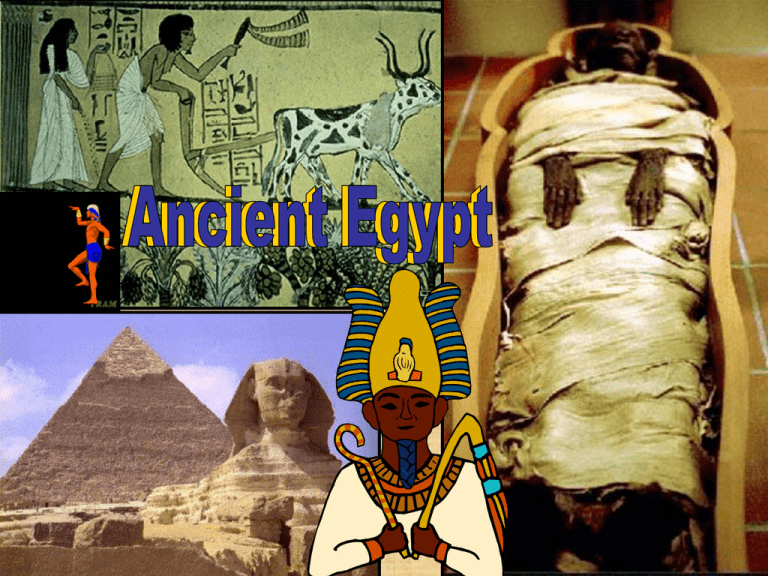
Old Kingdom 3,000 BC 2700 – 2200 BC Middle Kingdom New Kingdom 2050-1652 BC 1567 – 1085 BC •Called the “Gift of the Nile” and the “Miracle of the Nile.” •The yearly flooding of the Nile was predictable. •Flooded, leaving a Hymn to the Nile – “The bringer of food, rich deposit of fertile rich in provisions, creator of all good, lord of majesty, sweet of fragrance.” soil that forms a delta. •Longest river in the world. (4,000 miles). •Runs from the south to the north. •Largest, most heavily populated cities are located near the arable land next to the Nile river. •Black land – name given to the fertile, farming land. Red Land and Black Land above •Red land – name given to the land that is desert. •Farming surplus – made Egypt a wealthy region. •Nile river unified Upper and Lower Egypt. •Nile provided transportation and the ability to trade goods. •Natural barriers included deserts to their east and west, the Red Sea, and the Mediterranean Sea. •Natural barriers meant the Egyptians rarely feared invading armies. •Hieroglyphics – which means “priest carvings” or “sacred writings.” The Egyptian style of writing. •Scribes wrote on papyrus, a reed found in the Nile. •Papyrus=paper •Jean Francois Champollion cracked the code of Egyptian hieroglyphics with the Rosetta Stone. We could now read Egyptian hieroglyphics. •The Rosetta Stone had three languages, Egyptian, demotic and Greek. •Filled with hope. Secure and confident. • Sense of changelessness. •Prosperous and stable. •Belief in an afterlife. Pharaoh Grand Stewart or Vizier Upper class Nobles and Priests Merchants, Artisans, Scribes, and Tax collectors – strong middle class. Farmers – most people in Egypt were farmers. They paid taxes, lived in small villages, provided military service and labor for building projects. 1. What is the Egyptian style of writing called? 2.What did scribes write on? 3.Of what value was the Rosetta Stone? 4.Who was the most powerful person in Egypt? 5.Which group made up the largest % of the population? •The Egyptians were polytheistic with over 2,000 gods and goddesses. •The most important gods were the sun god, Ra, and land gods. •Their gods provided balance between order and chaos. Sun god, Ra •Osiris was the god of the Underworld and resurrection. •It is from the story of his death and resurrection, that Egyptians got their belief in the importance of mummification. •Isis was an important goddess. •Her bringing together of Osiris’s body and his resurrection were symbolic of the new life brought with the Nile’s yearly flood. •Began in 3100 BC when King Menes united Upper and Lower Egypt. •He wore the double crown of Egypt. •Menes established a dynasty of rulers or pharaohs. White crown-Upper Egypt and the Red Crown is for Lower Egypt. •Dynasty – a family of rulers whose right to rule is passed on to their children. •Power is usually transferred to the oldest male child. •Pharaoh – meant “great house” or “palace.” •They had absolute power. •Egyptian pharaoh’s were called the “Son of Ra.” 1. Were the Egyptians monotheistic or polytheistic? 2.Who was the god of the Underworld? 3.Who was the 1st pharaoh to unite Egypt? 4.A line of rulers from the same family is called this… 5.What does the term pharaoh mean? •The greatest accomplishment of the Old Kingdom was – •The building of the Great Pyramids at Giza. •Originally, mastabas were built to house pharaohs. Later, great pyramids were built. •Mastabas were then used to bury the pharaoh’s officials. •The Great Pyramids were built by King Khufu in Giza – 2,540 BC. •Largest and most magnificent of pyramids. •Pyramids had supplies for the pharaoh to enjoy when he returned from the dead. Supplies included: food, games, weapons, and boats. •Guarding the Great Pyramids is the Great Sphinx. •240 ft long, 66 ft. high. The Great Sphinx •It has the body of a lion and the head of a man, probably Khufu’s son, Khafre. •The process of mummifying a body was taken very seriously by priests. •First, the major organs were removed, and then the body was drained of all fluids and dried with natron (salt) for about 3 months. •Then, the major organs were wrapped and placed in canopic jars. •Finally, the body was carefully wrapped one layer at a time and placed in a sarcophagus. http://www.bbc.co.uk/history/ancient/egyptians/launch_gms_mummy_ma ker.shtml •2050 – 1652 BC. •Golden Age of stability and trade. •Conquered Nubia. •Traded with Kush, Syria, Mesopotamia, and Crete. •Egypt was the most powerful nation in the region. •Massive wealth and a new kingdom of powerful pharaohs. •Age of militarism and empire. •Hatshepsut -1st female pharaoh. •She dressed as a man, and claimed the gods wanted her to be pharaoh. •She built many temples. •Map to the temples that ran the length of the Nile river. •Amenhotep IV or Akhenaton – 1st pharaoh to claim that there was only one god, Aton, the sun. •He angered many priests by closing their temples. •Akhenaton was married to the world’s most beautiful woman, Queen Nefertiti. •Their son was King Tutankhamen, or King Tut, the “boy king.” •King Tutankhamen restored the old gods, but his memory was erased from history. •His tomb was the most famous because it was complete, and had not been looted. •Archaeologist Howard Carter made the most famous of all archaeological finds when he uncovered the tomb of the boy king. •Ramses the Great ruled the longest of all the pharaohs. He died at the age of 90. •He may have been the pharaoh that dealt with Moses. •Cleopatra II was the last of the Egyptian pharaohs. •Her challenge to Roman power was answered by defeat at the Battle of Actium and her suicide. •Writing – hieroglyphics. •Pyramids, temples and monuments. •Math – calculate area, volume. •365 day calendar. •Expertise in anatomy. •Great doctors and nurses. Medical training and expertise.

